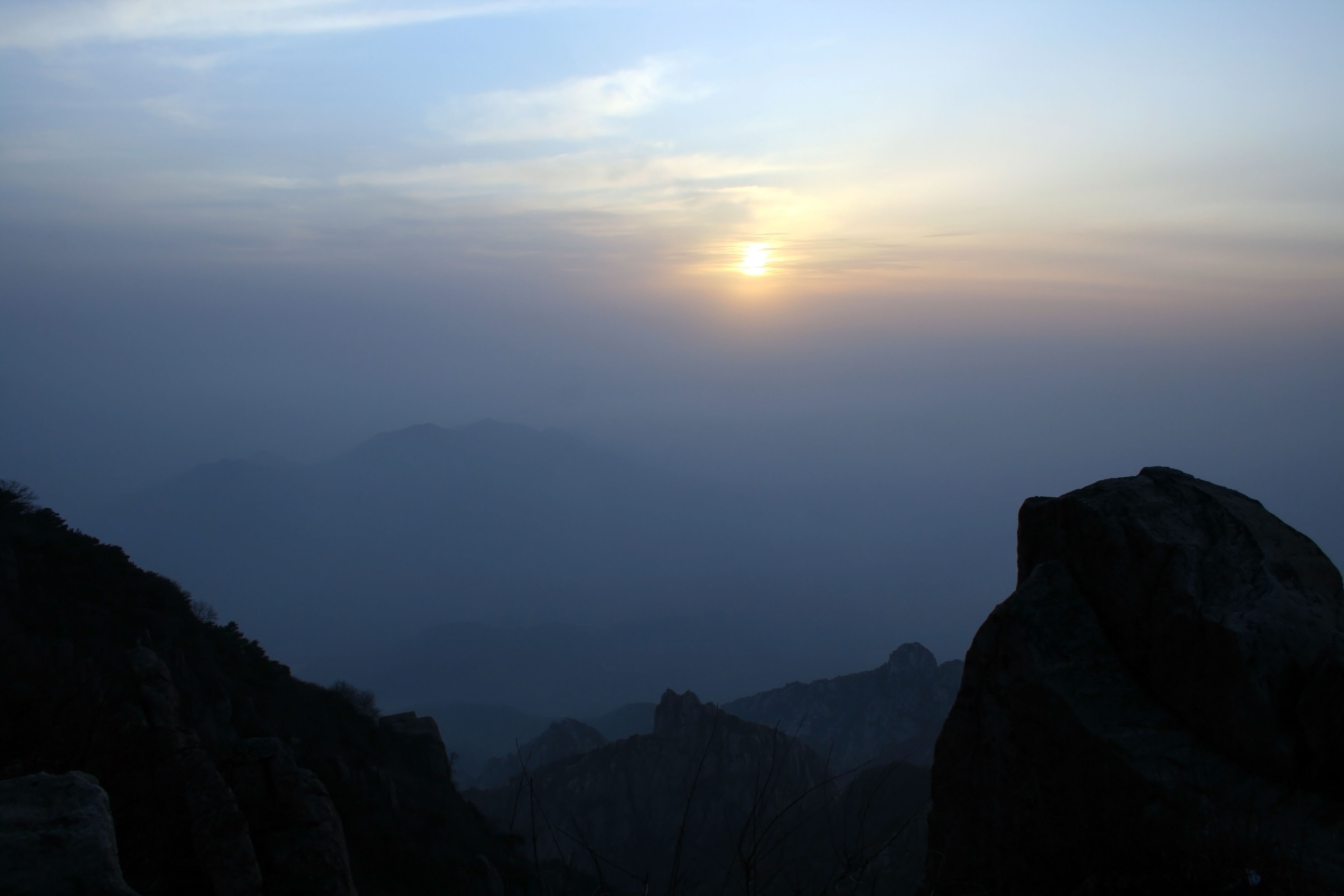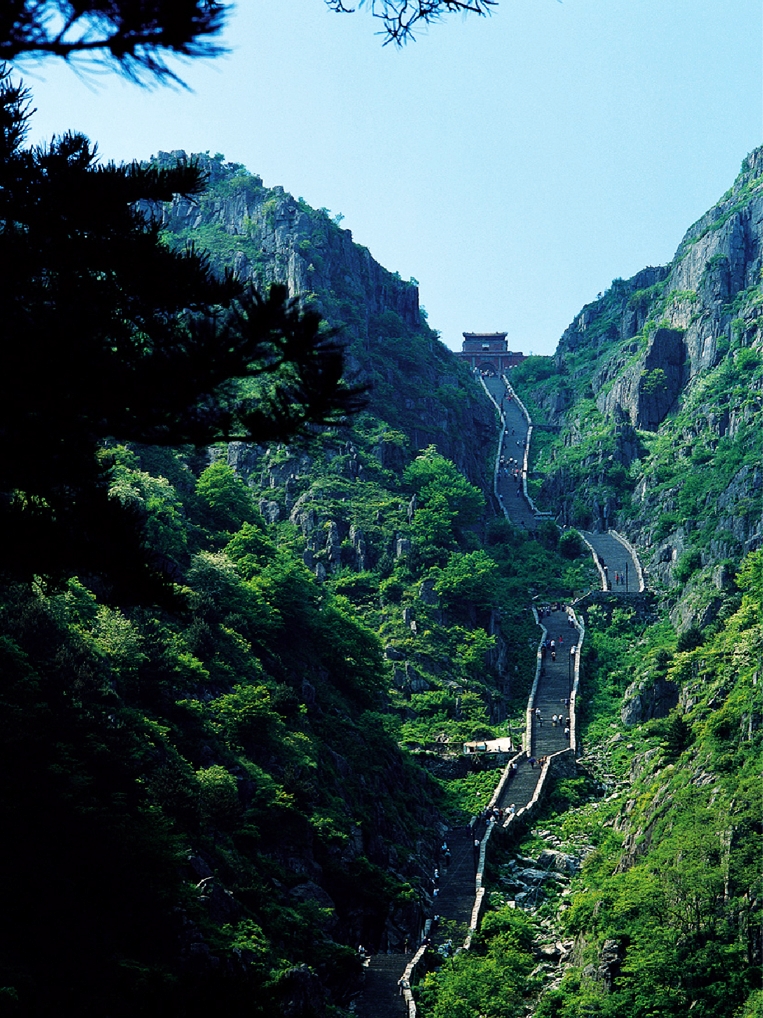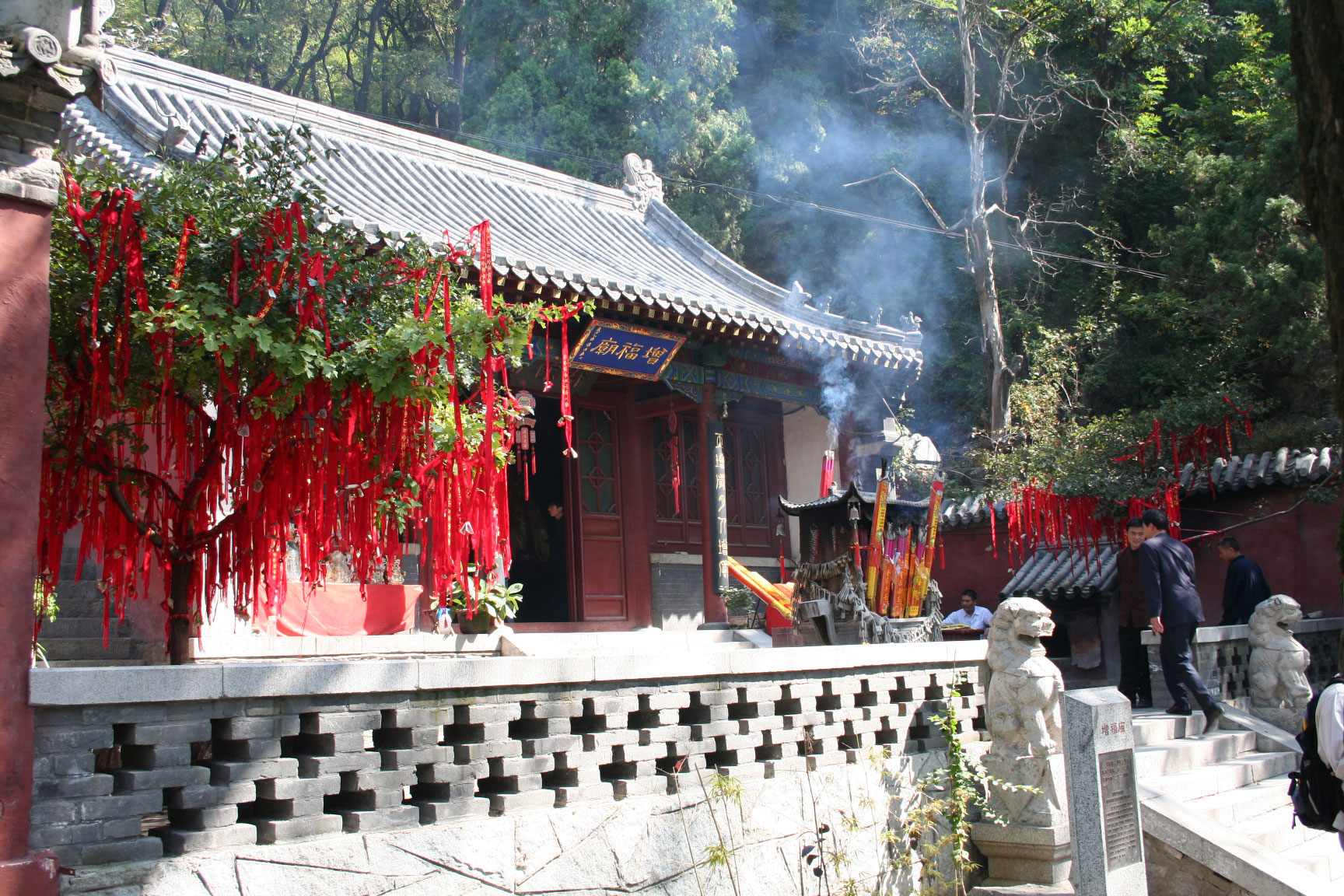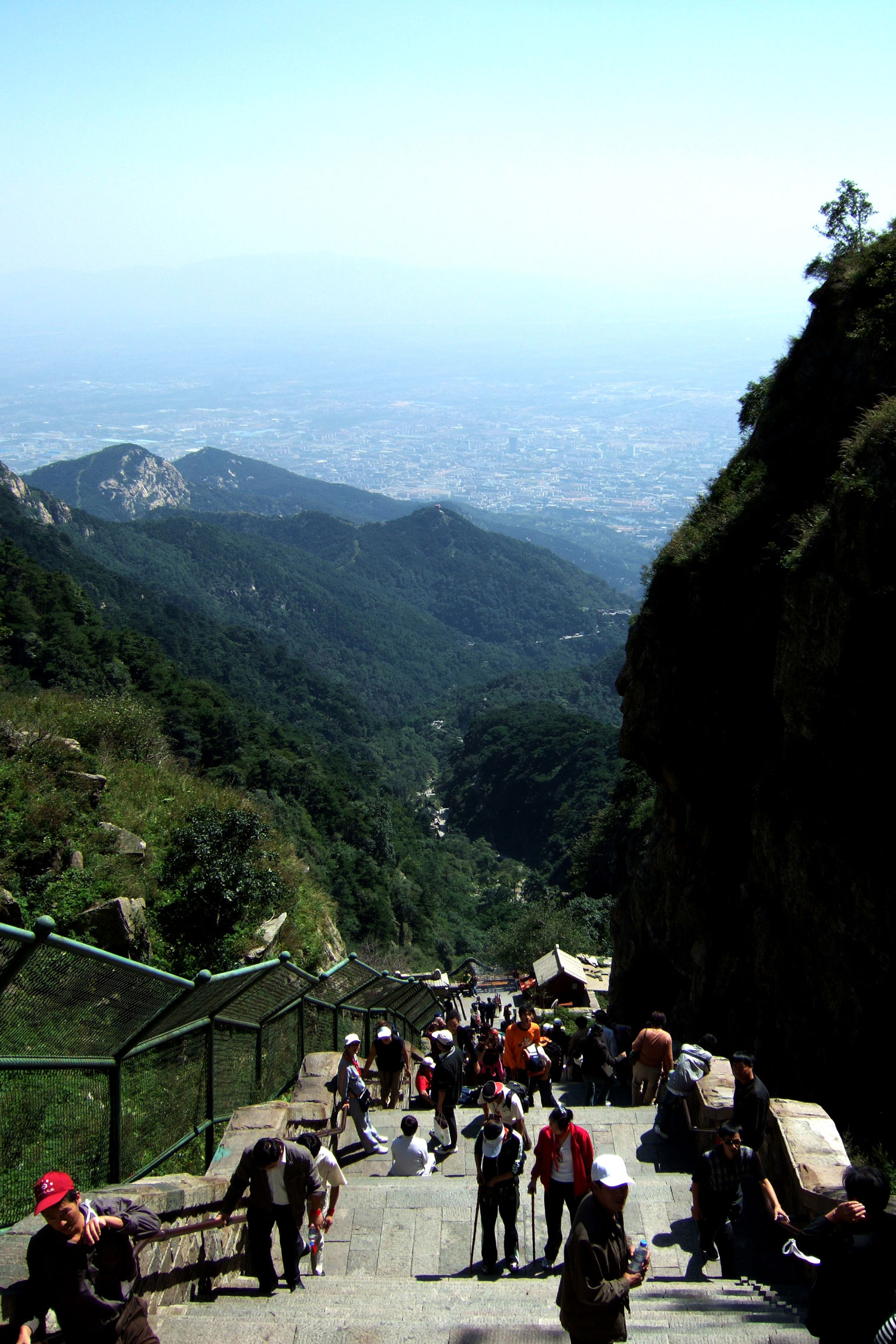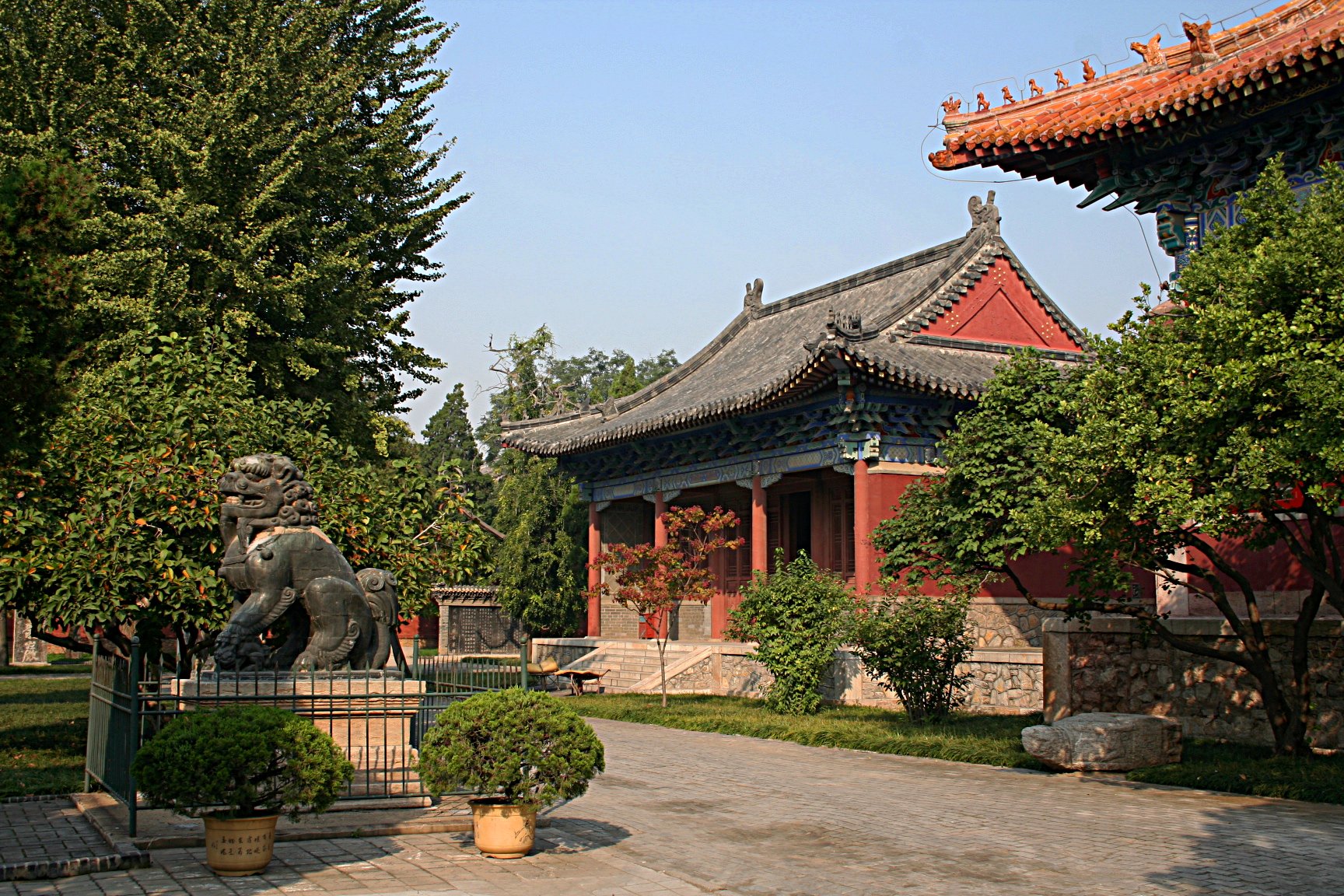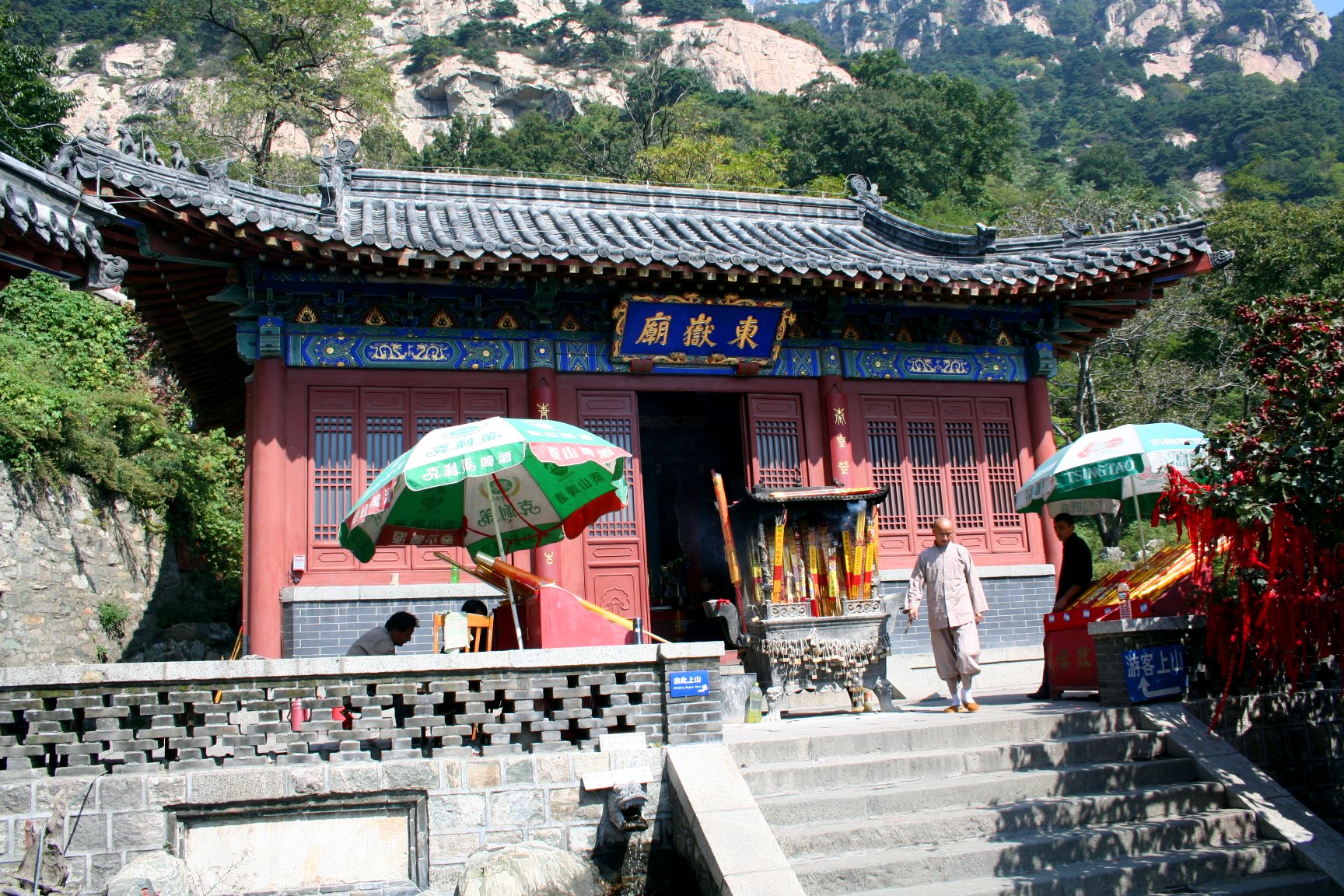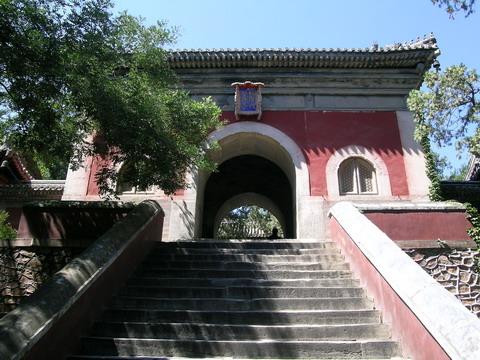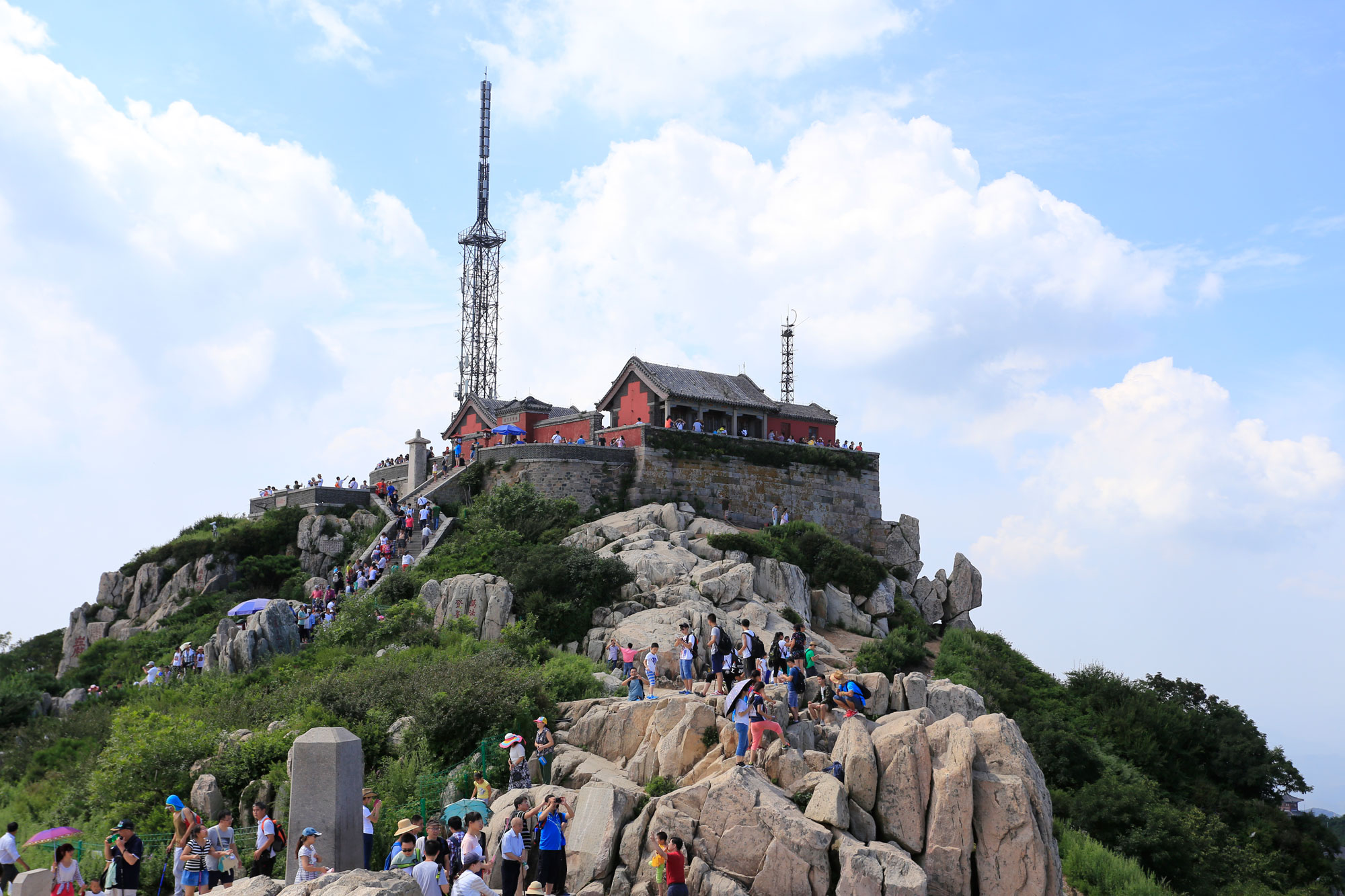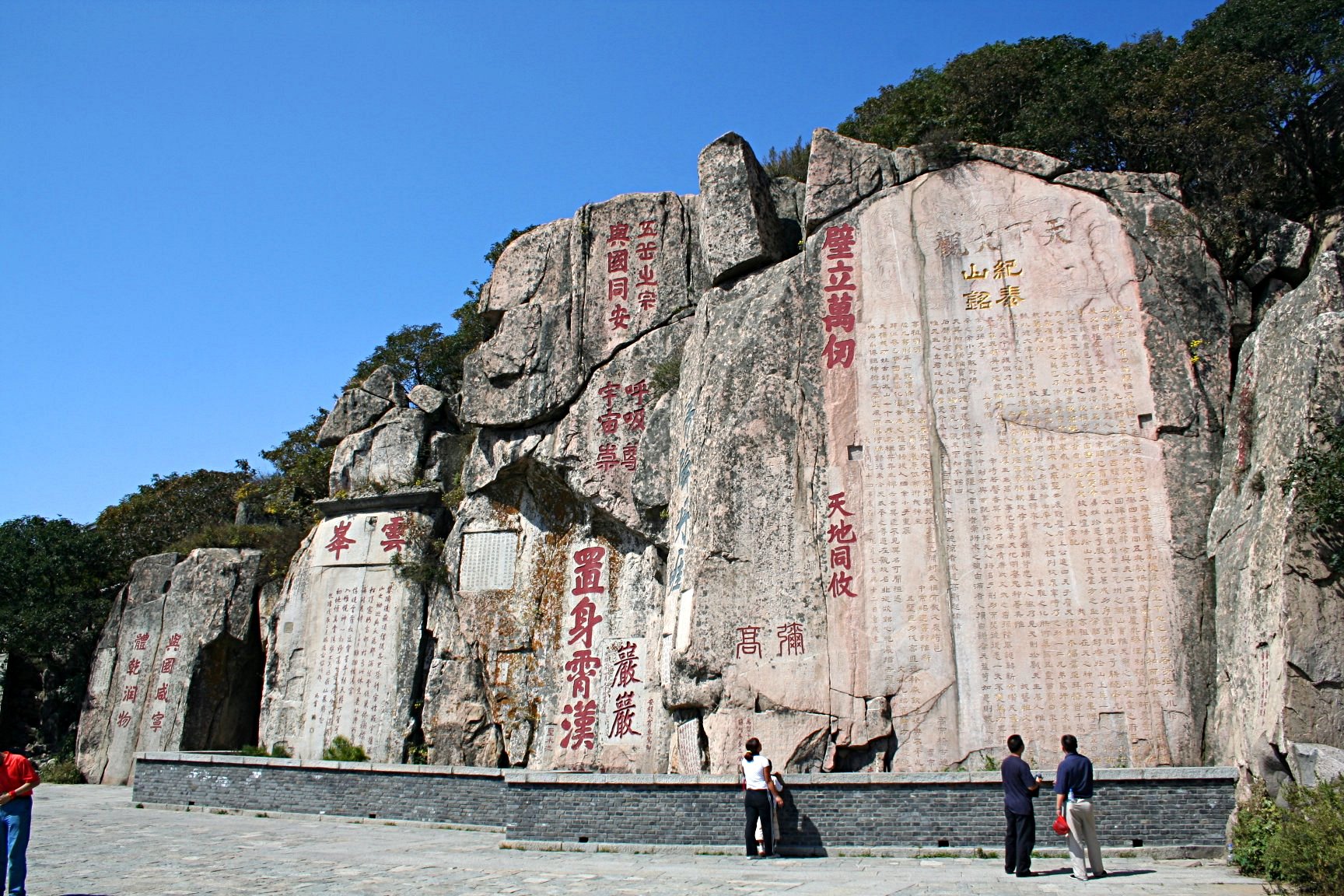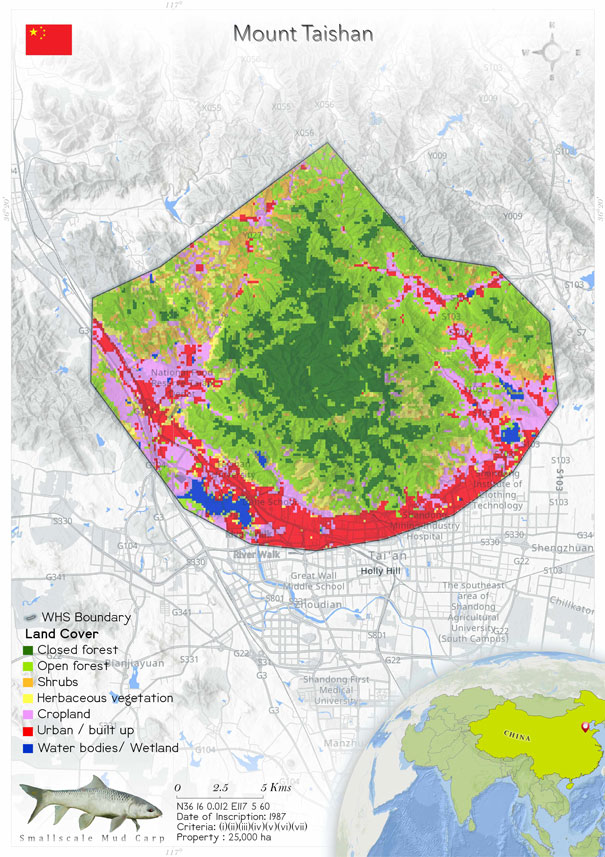
Mount Taishan (437)
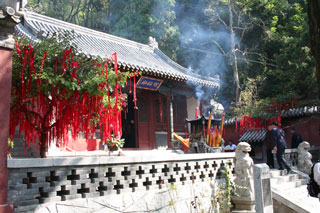 Mount Taishan manifests historic, cultural, scientific and aesthetic values. The site inspires scholars, artists and epitomizes civilizational beliefs and culture. The principal monument in Mount Taishan is the Temple to the God of Taishan, in which the 1009 CE Taoist painting “The God of Taishan Making a Journey” can be viewed. The site has inscriptions of the Han Dynasty and stelae of Zhang Qian, Heng Fang and Madam Jin Sun. The Valley of Inscribed Buddhist Scriptures in the Northern Qi Dynasty; the Eulogium of Taishan by Tang Xuanzong, and the Parallel Stelae of the Tang Dynasty. There are 1614 species of higher plant in 775 genera and 191 families in the property, and the faunal species include 25 mammal, 315 bird, 12 reptile and six amphibian species. All the architectural elements, paintings, in-situ sculptures, stone inscriptions and ancient trees are all integrated into the landscape of Mount Taishan. The site’s protection and management status are threatened by forest fires, dry conditions, disease infestation of trees, adverse impact of weather, loss of traditional culture and livelihoods and presence of cable cars in vulnerable places. The site’s ecological values have been threatened by diseases and insect pests, and the property faces pressures due to heavy tourism and high pollution levels, especially during festivals and holidays. There has been a lack of community engagement because the site has witnessed relocation of villagers who are not very involved in decision making. These factors have threatened local support for conservation and protection, compromising the efficiency of the conservation.
Mount Taishan manifests historic, cultural, scientific and aesthetic values. The site inspires scholars, artists and epitomizes civilizational beliefs and culture. The principal monument in Mount Taishan is the Temple to the God of Taishan, in which the 1009 CE Taoist painting “The God of Taishan Making a Journey” can be viewed. The site has inscriptions of the Han Dynasty and stelae of Zhang Qian, Heng Fang and Madam Jin Sun. The Valley of Inscribed Buddhist Scriptures in the Northern Qi Dynasty; the Eulogium of Taishan by Tang Xuanzong, and the Parallel Stelae of the Tang Dynasty. There are 1614 species of higher plant in 775 genera and 191 families in the property, and the faunal species include 25 mammal, 315 bird, 12 reptile and six amphibian species. All the architectural elements, paintings, in-situ sculptures, stone inscriptions and ancient trees are all integrated into the landscape of Mount Taishan. The site’s protection and management status are threatened by forest fires, dry conditions, disease infestation of trees, adverse impact of weather, loss of traditional culture and livelihoods and presence of cable cars in vulnerable places. The site’s ecological values have been threatened by diseases and insect pests, and the property faces pressures due to heavy tourism and high pollution levels, especially during festivals and holidays. There has been a lack of community engagement because the site has witnessed relocation of villagers who are not very involved in decision making. These factors have threatened local support for conservation and protection, compromising the efficiency of the conservation.
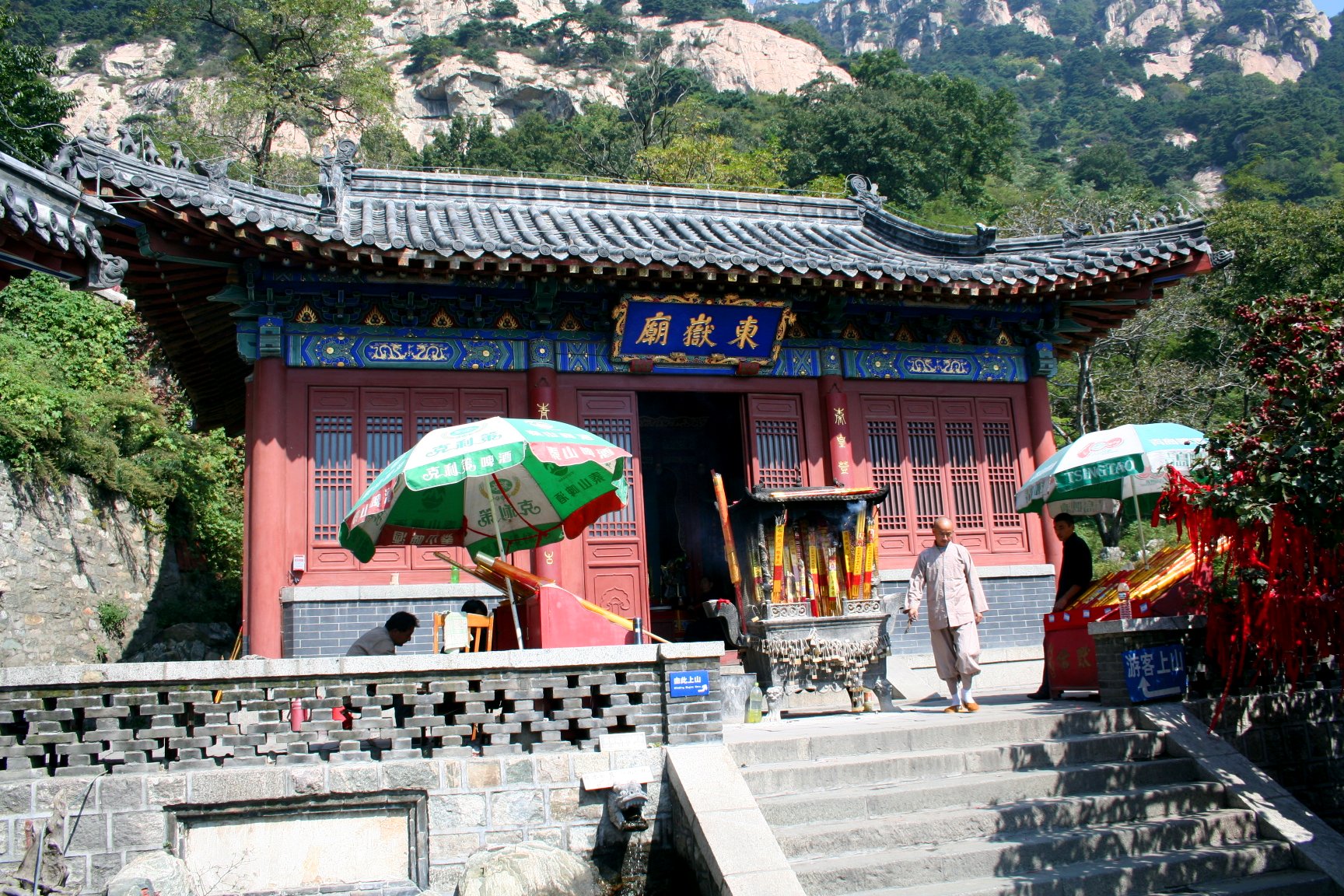 Mount Taishan exhibits an imperial band for 2000 years, and distinguished by the artistic masterpiece with the natural landscape and manifests historical, cultural, scientific, and aesthetic values. The site inspires scholars and artists and epitomizes civilizational beliefs and culture. It has witnessed natural evolution for nearly 3 billion years. It was formed through complex biological and geological processes that resulted in a gigantic rock mass surrounded by the dense vegetation of the plateau around it. The mountain displays a magnificent natural landscape that embodies the cultural aspects of thousands of years of human use and is valued in Chinese culture (World Heritage Committee 2012).
Historically, the settlements began during the Neolithic period and have been worshipped continuously during the last three millennia. The site has an area of 25,000 ha and rises 1545 m above the plateau. It is known as a beautiful scenic spot of China and impersonates oriental East Asian culture for the last three millennia. The mountain gave rise to the tradition of cult worship in 219 BCE, when the Qin emperor Huang Di. He honoured the mountain through the Fengshan sacrifices to inform the gods of his success in consolidating China. Twelve imperial ceremonies were conducted in reverence to heaven and earth that encompassed 1800 stone tablets and inscriptions and 22 temples. These together made Mount Taishan the most exceptional monument in China, representing a treasure house of history and culture (World Heritage Outlook 2020).
The principal monument of Mount Taishan is the Temple to the God of Taishan, where the 1009 CE Taoist painting “The God of Taishan Making a Journey” can be viewed. The site has inscriptions of the Han Dynasty stelae of Zhang Qian, Heng Fang and Madam Jin Sun, including the Valley of Inscribed Buddhist Scriptures, of the Northern Qi Dynasty, the Eulogium Taishan by Tang Xuanzong and the Parallel Stelae of the Tang Dynasty. The site has 1614 species of higher plant in 775 genera and 191 families, and the faunal species include 25 mammal, 315 birds, 12 reptile and six amphibian species (IUCN Consultation 2017). The architectural elements, paintings, in-situ sculptures, stone inscriptions and ancient trees are all integrated into the landscape of Mount Taishan (World Heritage Outlook 2020).
Mount Taishan exhibits an imperial band for 2000 years, and distinguished by the artistic masterpiece with the natural landscape and manifests historical, cultural, scientific, and aesthetic values. The site inspires scholars and artists and epitomizes civilizational beliefs and culture. It has witnessed natural evolution for nearly 3 billion years. It was formed through complex biological and geological processes that resulted in a gigantic rock mass surrounded by the dense vegetation of the plateau around it. The mountain displays a magnificent natural landscape that embodies the cultural aspects of thousands of years of human use and is valued in Chinese culture (World Heritage Committee 2012).
Historically, the settlements began during the Neolithic period and have been worshipped continuously during the last three millennia. The site has an area of 25,000 ha and rises 1545 m above the plateau. It is known as a beautiful scenic spot of China and impersonates oriental East Asian culture for the last three millennia. The mountain gave rise to the tradition of cult worship in 219 BCE, when the Qin emperor Huang Di. He honoured the mountain through the Fengshan sacrifices to inform the gods of his success in consolidating China. Twelve imperial ceremonies were conducted in reverence to heaven and earth that encompassed 1800 stone tablets and inscriptions and 22 temples. These together made Mount Taishan the most exceptional monument in China, representing a treasure house of history and culture (World Heritage Outlook 2020).
The principal monument of Mount Taishan is the Temple to the God of Taishan, where the 1009 CE Taoist painting “The God of Taishan Making a Journey” can be viewed. The site has inscriptions of the Han Dynasty stelae of Zhang Qian, Heng Fang and Madam Jin Sun, including the Valley of Inscribed Buddhist Scriptures, of the Northern Qi Dynasty, the Eulogium Taishan by Tang Xuanzong and the Parallel Stelae of the Tang Dynasty. The site has 1614 species of higher plant in 775 genera and 191 families, and the faunal species include 25 mammal, 315 birds, 12 reptile and six amphibian species (IUCN Consultation 2017). The architectural elements, paintings, in-situ sculptures, stone inscriptions and ancient trees are all integrated into the landscape of Mount Taishan (World Heritage Outlook 2020).
Criterion (ii)
 Mount Taishan, the most venerated of mountains in China, exerted for 2,000 years multiple and wide-ranging influence on the development of art. The Temple to the God of Taishan and the Azure Cloud Temple, dedicated to his daughter, the Goddess Laomu, were prototypes built on Mount Taishan and subsequently used as models during the imperial period, throughout all of China. The conceptual model of a mountain bearing the traces of man, where graceful structures – bridges, gateways or pavilions – contrast with sombre pine forests or frightening rocky cliffs, could only have originated by referring to Mount Taishan.
Mount Taishan, the most venerated of mountains in China, exerted for 2,000 years multiple and wide-ranging influence on the development of art. The Temple to the God of Taishan and the Azure Cloud Temple, dedicated to his daughter, the Goddess Laomu, were prototypes built on Mount Taishan and subsequently used as models during the imperial period, throughout all of China. The conceptual model of a mountain bearing the traces of man, where graceful structures – bridges, gateways or pavilions – contrast with sombre pine forests or frightening rocky cliffs, could only have originated by referring to Mount Taishan.
Criterion (iii)
Mount Taishan bears unique testimony to the lost civilizations of imperial China, most particularly in relation to their religions, arts and letters. For 2,000 years it was one of the principal places of worship where the emperor paid homage to Heaven and Earth in the Fengshan sacrifices, conducted by the Son of Heaven himself. Since the time of the Han Dynasty, it has been one of the five mountains symbolizing the Celestial Kingdom, in accordance with the Doctrine of the Five Elements, a fundamental premise in Chinese thought.
Criterion (iv)
Mount Taishan is an outstanding example of a sacred mountain. The Palace of Heavenly Blessings (1,008 CE), located inside the Temple to the God of Taishan, is one of the three oldest palaces in China. The Azure Cloud Temple, also constructed under the Song Dynasty, is typical of a mountain architectural complex in the arrangement of its courtyards and buildings and the Divine Rock Temple with its Thousand Buddhas Hall are outstanding and complete examples of great temples. Together they illustrate the cultural and religious aspects of the Tang and Song periods.
Criterion (v)
The natural and cultural ensemble of Mount Taishan comprises a traditional human settlement in the form of a cult centre dating from the Neolithic (Dawenkou) period, which has become an outstanding example of traditional culture under the impact of irreversible change wrought by increasing visitation and tourism.
Criterion (vi)
Mount Taishan is directly and tangibly associated with events whose importance in universal history cannot be minimized. These include the emergence of Confucianism, the unification of China, and the appearance of writing and literature in China.
Criterion (vii)
With nearly 3 billion years of natural evolution, Mount Taishan was formed through complicated geological and biological processes, which resulted in a gigantic rock mass covered with dense vegetation towering over the surrounding plateau. This dramatic and majestic mountain is an outstanding combination of a beautiful natural landscape dominated by the cultural impacts of thousands of years of human use.
Status
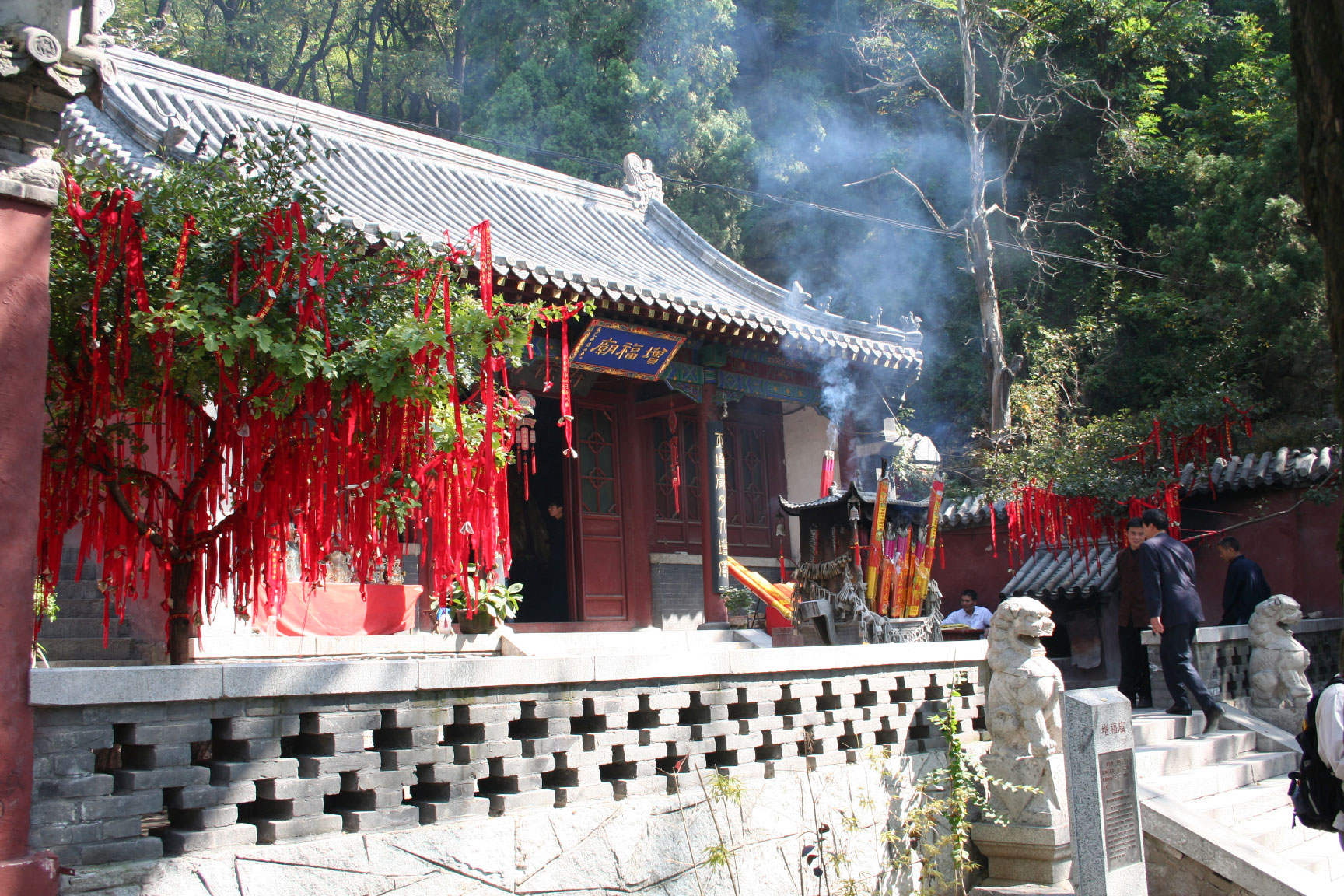 There has been a decrease in the area of the Pinus forests through conversion to the Quercus and mixed forests that have developed in scattered areas across the site. According to a recent study, approximately two-thirds of the forests in Mount Taishan are in an unhealthy state. The number of dead trees in the site has increased (Meng et al. 2019). The degradation may be due to forest diseases and pests and may also include other factors. Such threats can adversely affect the ecological environment and the scenic values of Taishan (State Party of China 2003). Several regulations have been promulgated, such as the Ecological Protection of Taishan Scenic Spots (May 2018). This law focuses on financing, monitoring, management, and responsible parties, marking the importance of ecological restoration highlighting "nonopen area and closed rotation area" mainly to account for over-visitation (Tai-an Municipal Government 2018).
There has been limited community engagement as a result of relocation of villagers, who are not much involved in decision-making. These factors have threatened local support for conservation and protection, compromising the conservation efficiency (Xiang 2009). The relocation programme caused changes in lifestyle and tradition, loss of tourism business and revenue, and unequal compensation and benefits. A few were able to stay, and others were relocated. The residents have become the custodians, rather than conservation professionals (Xiang & Wall 2016). The Taishan Municipal Administrative Committee of the Taishan Scenic and Historic Interest Zone manages the protection and administrative services.
The property is protected at the regional level as the Shandong People's Congress promulgated the Regulations to Conserve Taishan in 1991 (State Party of China 2003a, 2003b). Apart from this law, there are regulations for Taishan National Park and for the National Parks of Shandong Province that was restored in 2016 and 2017 (IUCN Consultation, 2017). The Rural Revitalization Strategy of the government underscores the well-being of the rural local people and revitalization of rural culture. It strengthens efforts to draw in rural culture, ensuring that the local people will share the tourism benefits accruing from the heritage mountain (Xiang 2020).
The site's geology, topography, biodiversity, cultural relics, forest fires, and pine diseases have been studied through joint efforts of the Ministry of Urban and Rural Construction and the Environment Protection of Beijing University to gain a systematic understanding of the site (WCMC 2011). Research indicates that there have been significant improvements in terms of resource conservation, visitor experience and local well-being (Xiang 2009). Taishan is of great significance as it is a sacred mountain that the local population worships as their mother due to the sacred trees, rocks and temples. Therefore, it must be protected for its Chinese heritage and culture.
There has been a decrease in the area of the Pinus forests through conversion to the Quercus and mixed forests that have developed in scattered areas across the site. According to a recent study, approximately two-thirds of the forests in Mount Taishan are in an unhealthy state. The number of dead trees in the site has increased (Meng et al. 2019). The degradation may be due to forest diseases and pests and may also include other factors. Such threats can adversely affect the ecological environment and the scenic values of Taishan (State Party of China 2003). Several regulations have been promulgated, such as the Ecological Protection of Taishan Scenic Spots (May 2018). This law focuses on financing, monitoring, management, and responsible parties, marking the importance of ecological restoration highlighting "nonopen area and closed rotation area" mainly to account for over-visitation (Tai-an Municipal Government 2018).
There has been limited community engagement as a result of relocation of villagers, who are not much involved in decision-making. These factors have threatened local support for conservation and protection, compromising the conservation efficiency (Xiang 2009). The relocation programme caused changes in lifestyle and tradition, loss of tourism business and revenue, and unequal compensation and benefits. A few were able to stay, and others were relocated. The residents have become the custodians, rather than conservation professionals (Xiang & Wall 2016). The Taishan Municipal Administrative Committee of the Taishan Scenic and Historic Interest Zone manages the protection and administrative services.
The property is protected at the regional level as the Shandong People's Congress promulgated the Regulations to Conserve Taishan in 1991 (State Party of China 2003a, 2003b). Apart from this law, there are regulations for Taishan National Park and for the National Parks of Shandong Province that was restored in 2016 and 2017 (IUCN Consultation, 2017). The Rural Revitalization Strategy of the government underscores the well-being of the rural local people and revitalization of rural culture. It strengthens efforts to draw in rural culture, ensuring that the local people will share the tourism benefits accruing from the heritage mountain (Xiang 2020).
The site's geology, topography, biodiversity, cultural relics, forest fires, and pine diseases have been studied through joint efforts of the Ministry of Urban and Rural Construction and the Environment Protection of Beijing University to gain a systematic understanding of the site (WCMC 2011). Research indicates that there have been significant improvements in terms of resource conservation, visitor experience and local well-being (Xiang 2009). Taishan is of great significance as it is a sacred mountain that the local population worships as their mother due to the sacred trees, rocks and temples. Therefore, it must be protected for its Chinese heritage and culture.
